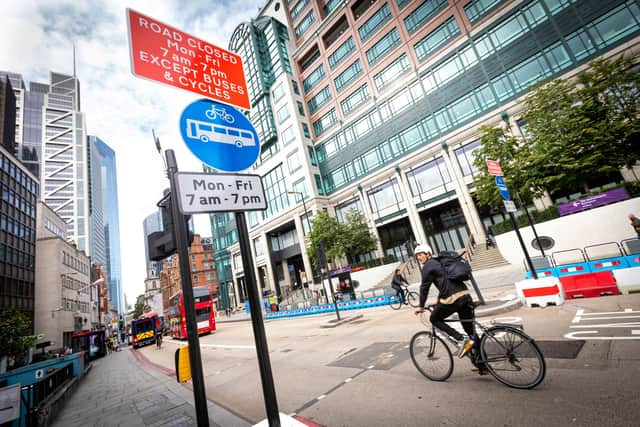TfL Bishopsgate A10 scheme: Road changes to be made permanent amid huge uptick in cycling journeys
and live on Freeview channel 276
Transport for London (TfL) is making road changes introduced in Bishopsgate during the pandemic permanent, after data indicated it has encouraged thousands more cycling trips and faster bus times.
TfL temporarily implemented a host of changes to the A10 in August 2020, including restrictions on vehicles using the road between 7am and 7pm on weekdays, widening footways and a number of banned turns.
Advertisement
Hide AdAdvertisement
Hide AdSince they were introduced, TfL data suggests bus journeys have been cut by two minutes per kilometre northbound and one and a half minutes southbound.
Thousands more cyclists have also been recorded in Bishopsgate since August 2020, with an average of 7,500 journeys per day compared to 5,700 in 2019, with peaks of 9,000 cyclists reported.


TfL said there will be further short-term upgrades and public realm improvements in the future.
Helen Cansick, TfL’s head of healthy streets investment, said: “We’re determined to ensure that people can walk and cycle safely across the capital and our data suggests that the changes we’ve made along Bishopsgate have played an important role in promoting healthy and sustainable ways of travelling in London.
Advertisement
Hide AdAdvertisement
Hide Ad“As a result of our bold changes here, it has become much safer for vulnerable road users, and bus journey times have reduced.”
Will Norman, London’s walking and cycling commissioner, said: "These changes at Bishopsgate have made a huge difference to the way people travel through the area, which is why I’m delighted they’ll now be made permanent.
“The area has become safer for both pedestrians and cyclists, and bus journey times have reduced thanks to the new vehicle restrictions on the road.
“Schemes like this support our aim to continue building a safer, greener and fairer Londoner for everyone.”
Advertisement
Hide AdAdvertisement
Hide AdLondon’s cycleway network has developed at pace in recent years. Between 2016 and 2022, it grew from 90km to more than 340km, with more than one in five Londoners now living near the network.
Since April 2022, TfL and the boroughs have delivered 24km of new or improved cycleways, with another 40km planned by March 2024.
Comment Guidelines
National World encourages reader discussion on our stories. User feedback, insights and back-and-forth exchanges add a rich layer of context to reporting. Please review our Community Guidelines before commenting.
